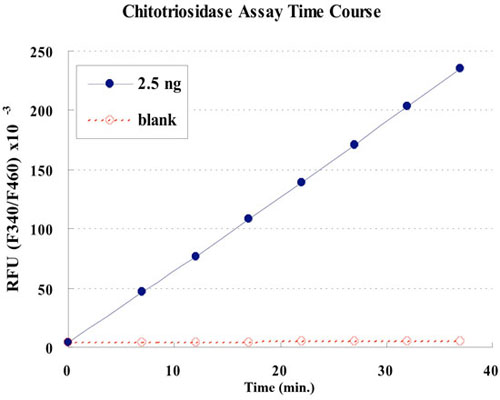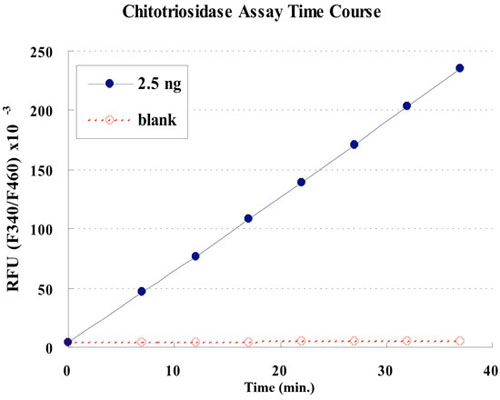CycLex Chitotriosidase Fluorometric Assay Kit
| Code | Size | Price |
|---|
| MBL-CY-1249 | 100 Assays | £619.00 |
Quantity:
Prices exclude any Taxes / VAT
Overview
Regulatory Status: RUO
Shipping:
Dry Ice
Storage:
-70°C
Images
Documents
Further Information
Applications:
Other - 1) Measuring chitotriosidase activity in serum/plasma and other biological samples.
2) Evaluating the effects of pharmacological compounds on chitotriosidase activity.
3) Screening inhibitors or activators of chitotriosidase.
Background:
Chitotriosidase was discovered in plasma of patients suffering from Gaucher?s disease; it was found that the 1,000-fold-elevated enzyme originates from lipid-laden macrophages that accumulate in various tissues of Gaucher?s patients (1). Chitotriosidase has subsequently been purified from the spleen of a Gaucher?s patient and its cDNA was cloned from a human macrophage cDNA library (2, 3). This enzyme is a human chitinase member of family 18 glycosyl hydrolases (3?5), and has the capability to hydrolyze chitin. This enzyme is selectively expressed in activated tissue macrophages that accumulate in various tissues of several lysosomal diseases (6). Therefore its activity has been proposed as a biochemical marker of macrophage accumulation in Gaucher?s disease (1, 7). In some other inherited lysosomal storage disorders, especially sphingolipidoses such as Niemann Pick, GM1-gangliosidosis, and Krabbe disease, which involve accumulation of different lipids, more modest elevations in plasma chitotriosidase have been noted (7). Chitotriosidase is the only biomarker identified up to date for the monitoring the efficacy of the extremely costly enzyme-replacement therapy of Gaucher patients and male Fabry patients (8).
Elevated levels of serum chitotriosidase were also found in disorders caused by the abnormal activation of immune system, including sarcoidosis (9) and atherosclerosis (10, 11). It has been shown that chitotriosidase activity was elevated up to 55-fold in extracts of atherosclerotic tissue, showing a clear connection between chitotriosidase expression and lipid-laden macrophages inside human atherosclerotic vessel wall (10). Human chitotriosidase also associates with pathogen-driven diseases, and in particular with fungal infections, suggesting the role of this enzyme in host defense against chitin-containing pathogens (12, 13). Other clinical data for instance show that chitotriosidase activity is raised in plasma of African children infected with acute Plasmodium falciparum malaria (14). Additional evidence for a role of chitotriosidase during immunological responses is the observation that the enzyme is shortly and acutely up-regulated both at the level of mRNA and activity following stimulation with prolactin, IFN-γ, TNF α and LPS, but not with IL-10 (15, 16).
In the blood stream, tissue macrophages largely secrete newly synthesized 50-kDa chitotriosidase, but about one-third is directly routed to lysosomes and proteolytically processed to the 39-kDa unit that remains catalytically active (17). A common chitotriosidase gene polymorphism leads to a null allele and therefore a defective enzyme activity. In white populations, 30% to 40% of individuals are carriers of this abnormal chitotriosidase allele and approximately 6% are homozygous (1, 18).
Description:
The CycLex Research Product CycLex Chitotriosidase Fluorometric Assay kit is used for the quantitative measurement of chitotriosidase activity in serum/plasma, culture supernatant of activated macrophages and other biological samples.
Kit Components:
10X Chitotriosidase Assay Buffer, 50X Fluoro-Substrate, Recombinant Chitotriosidase, 10X Stop Solution, 4-Methylumbelliferone Standard, Instruction manual
Target:
CHITO
References
1 Hollak, C. E., van Weely, S., van Oers, M. H. and Aerts, J. M. (1994). Marked elevation of plasma chitotriosidase activity. A novel hallmark of Gaucher disease. J. Clin. Invest. 93: 1288.
2 Renkema, G. H., Boot, R. G., Muijsers,A.O., Donker-Koopman, W. E. and Aerts, J. M. (1995). Purification and characterization of human chitotriosidase, a novel member of the chitinase family of proteins. J. Biol. Chem. 270: 2198.
3 Boot, R. G., Renkema, G. H., Strijland, A., van Zonneveld, A. J. and Aerts, J. M. (1995). Cloning of a cDNA encoding chitotriosidase, a human chitinase produced by macrophages. J. Biol. Chem. 270: 26252.
4. Hakala BE, White C, Recklies AD. (1993) Human cartilage gp-39, a major secretory product of articular chondrocytes and synovial cells, is a mammalian member of chitinase protein family. J Biol Chem. 268: 25803.
5. Renkema GH, Boot RG, Au FL, Donker-Koopman WE, Strijland A, Muijsers AO, Hrebicek M, Aerts JM. (1998) Chitotriosidase, a chitinase, and the 39-kDa human cartilage glycoprotein, a chitin-binding lectin, are homologues of family 18 glycosyl hydrolases secreted by human macrophages. Eur J Biochem. 251: 504.
6. Aerts, J. M., and Hollak, C. E. (1997) Plasma and metabolic abnormalities in Gaucher's disease. Baillieres Clin. Haematol. 10: 691.
7. Guo Y, He W, Boer AM, Wevers RA, de Bruijn AM, Groener JE, Hollak CE, Aerts JM, Galjaard H, van Diggelen OP. (1995) Elevated plasma chitotriosidase activity in various lysosomal storage disorders. J Inher Metab Dis. 18: 717.
8. Vedder, A.C., Cox-Brinkman, J., Hollak, C.E. et al. (2006) Plasma chitotriosidase in male Fabry patients: A marker for monitoring lipid-laden macrophages and their correction by enzyme replacement therapy. Mol. Genet. Metab. 89: 239.
9. Grosso, S., Margollicci, M.A., Bargagli, E. et al. (2004) Serum levels of chitotriosidase as a marker of disease activity and clinical stage in sarcoidosis. Scand. J. Clin. Lab. Invest.. 64: 57.
10. Boot, R.G., van Achterberg, T.A., van Aken, B.E. et al. (1999) Strong induction of members of the chitinase family of proteins in atherosclerosis: chitotriosidase and human cartilage gp-39 expressed in lesion macrophages. Arterioscler. Thromb. Vasc. Biol. 19: 687.
11. Artieda, M., Cenarro, A., Ganan, A. et al. (2003) Serum chitotriosidase activity is increased in subjects with atherosclerosis disease. Arterioscler. Thromb. Vasc. Biol. 23: 1645.
12. Labadaridis, J., Dimitriou, E., Costalos, C. et al. (1998) Serial chitotriosidase activity estimations in neonatal systemic candidiasis. Acta Paediatr. 87: 605.
13. Labadaridis, I., Dimitriou, E., Theodorakis, M. et al. (2005) Chitotriosidase in neonates with fungal and bacterial infections. Arch. Dis. Child Fetal Neonatal Ed. 90: F531.
14. Barone, R., Simpore, J., Malaguarnera, L., Pignatelli, S. And Musumeci, S. (2003) Plasma chitotriosidase activity in acute Plasmodium falciparum malaria. Clin. Chim. Acta 331: 79.
15. Di Rosa, M., Musumeci, M., Scuto, A., Musumeci, S. and Malaguarnera, L. (2005) Effect of interferon-gamma, interleukin-10, lipopolysaccharide and tumor necrosis factor-alpha on chitotriosidase synthesis in human macrophages. Clin. Chem. Lab. Med. 43: 499.
16. Malaguarnera, L.,Musumeci,M., Licata, F., Di Rosa,M.,Messina, A. and Musumeci, S. (2004) Prolactin induces chitotriosidase gene expression in human monocyte-derived macrophages. Immunol. Lett. 94: 57.
17. Renkema, G. H., Boot, R. G., Strijland, A. Donker-koopman, W. E., van den Berg, M., Muijsers, A. O., and Aerts, J. M. F. G. (1997) Synthesis, sorting, and processing into distinct isoforms of human macrophage chitotriosidase. Eur. J. Biochem. 244: 279
18. Eiberg H, den Tandt WR. (1997) Assignment of human plasma methylumbelliferyl -tetra-N-acetylchitotetraoside or chitinase to chromosome 19 by a linkage study. Hum Genet. 101: 205.




